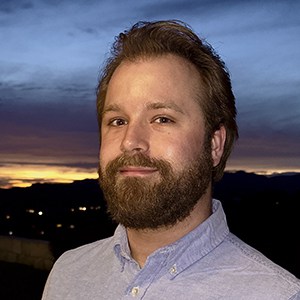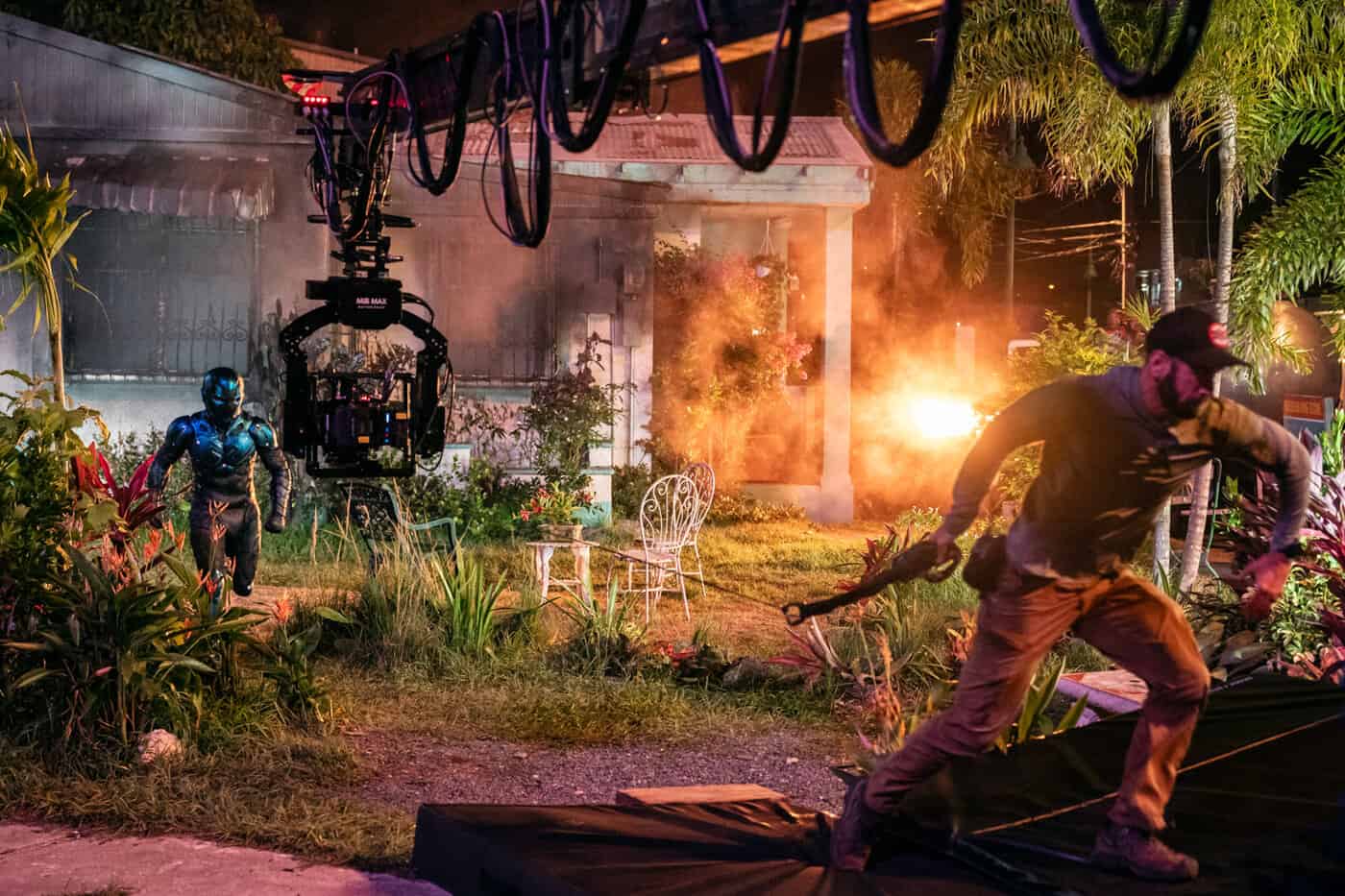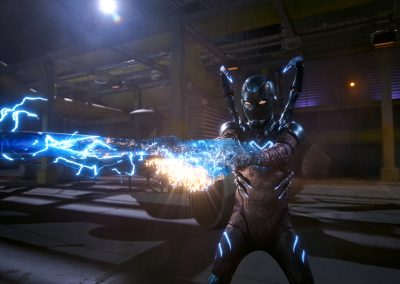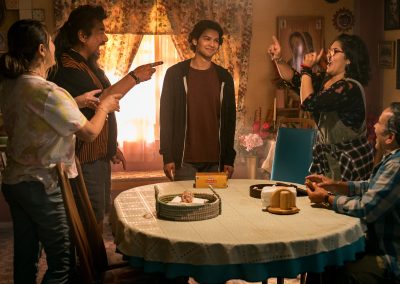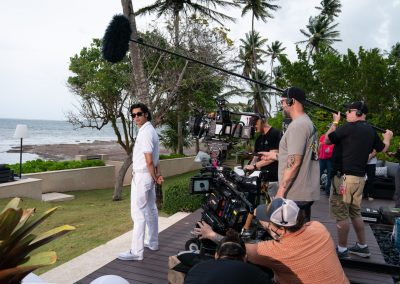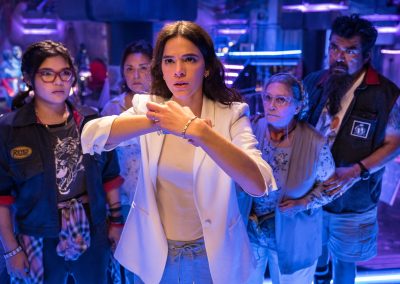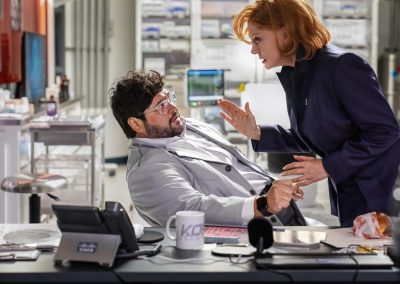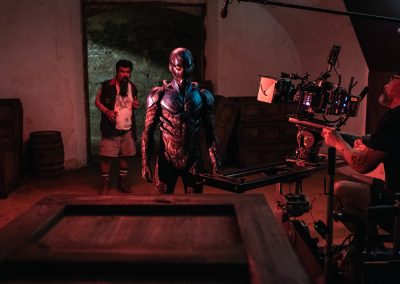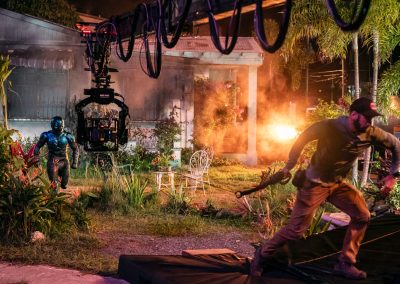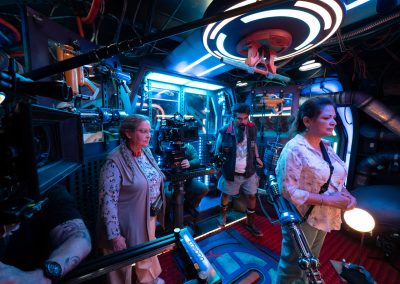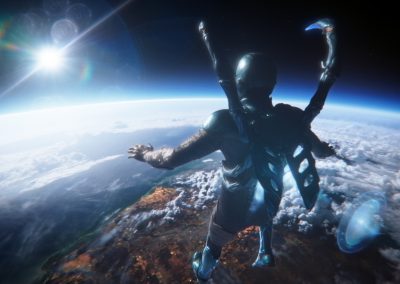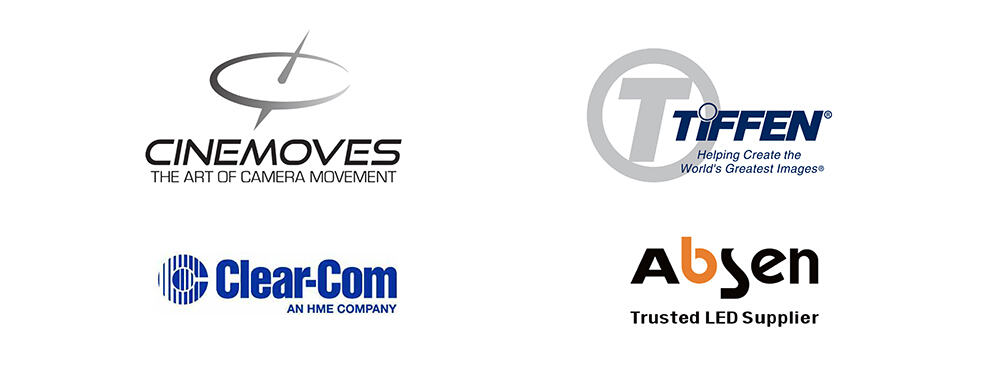Blue Beetle
A Different Kind of Superhero Movie
A Conversation with Christopher T.J. McGuire, SOC, ACO, GBCT
By David Daut
Though various incarnations of the superhero Blue Beetle have appeared on comic book pages since 1939, the current version of the character is a somewhat recent addition to the DC Comics pantheon. Introduced in 2006, Jamie Reyes, the son of Mexican-American immigrants, became the third character to don the mantle of the Blue Beetle. His jump to the silver screen marks the first major superhero movie featuring a Latino lead.
Christopher T.J. McGuire, SOC, ACO, GBCT—A Camera and Steadicam operator on Blue Beetle—is no stranger to shooting on these kinds of blockbuster superhero films, having worked on films for DC, Marvel, and Sony. Camera Operator had the chance to chat with him about his work on the film and how its more intimate scale and focus on familial bonds made it distinct from the other comic book movies he’s worked on.
Fresh out of college, Jaime Reyes returns to his hometown to find that his family is facing the threat of eviction from his childhood home. On the hunt for work to save his family’s home, a chance meeting lands him a job interview at mega-corporation Kord Industries, where the young heir of the Kord fortune uses Jaime to unwittingly help steal an alien artifact from Kord’s experimental weapons division. This artifact, known as the Scarab, ends up bonding with Jaime, transforming him into the superhero Blue Beetle. Now, on the run from Kord’s army of mercenaries, Jaime has to wrestle with both his newfound power as well as his sense of responsibility to his family. Blue Beetle is directed by Ángel Manuel Soto from a screenplay by Gareth Dunnet-Alcocer and stars Xolo Maridueña as Jaime Reyes alongside Adriana Barraza, Damián Alcázar, Raoul Max Trujillo, Susan Sarandon, and George Lopez.
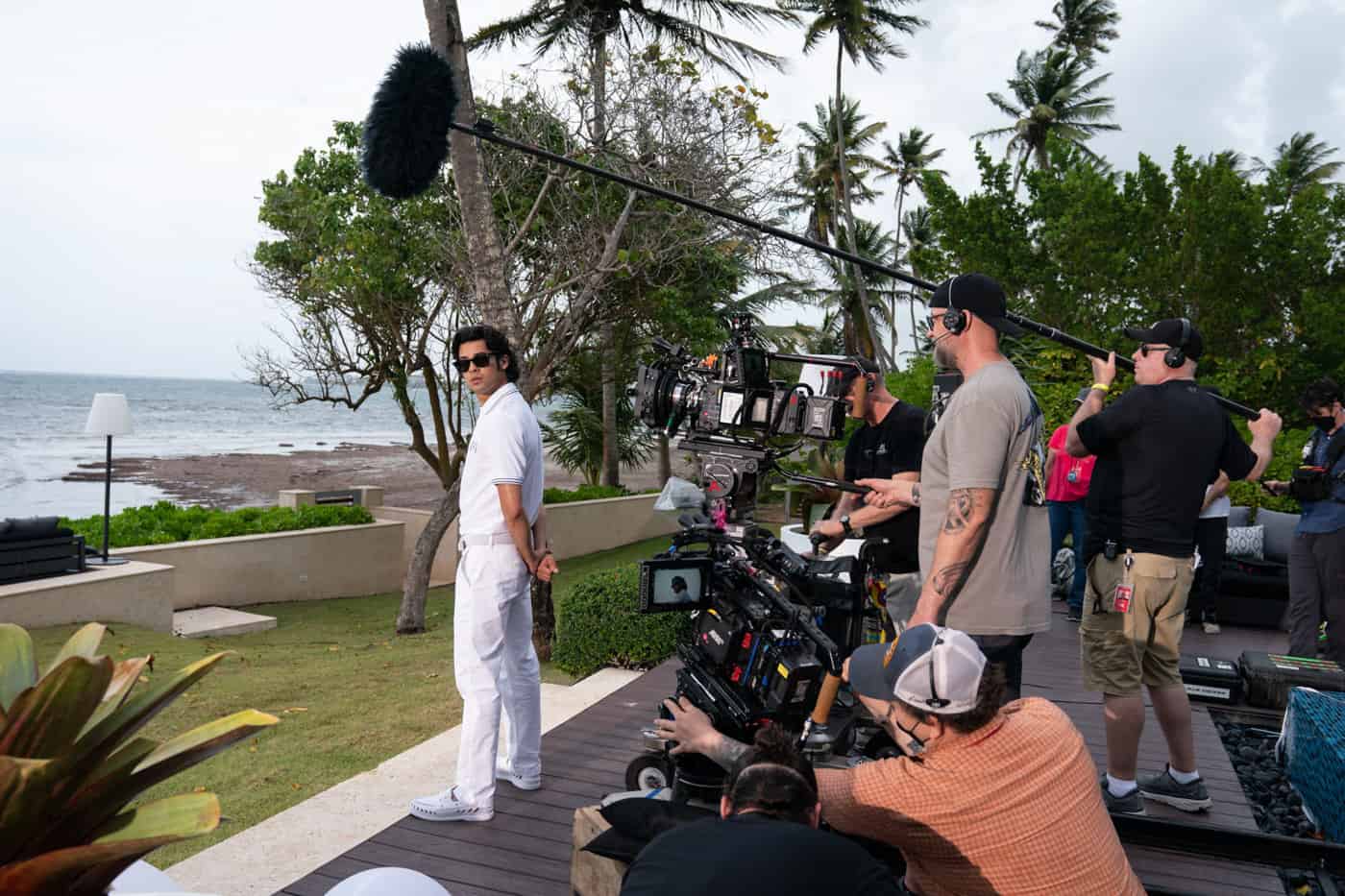
Xolo Maridueña as Jaime Reyes with Camera Operator Christopher T.J. McGuire, SOC, ACO, GBCT, on the set of BLUE BEETLE
Camera Operator: So, to start, I’m curious how you came to be involved with Blue Beetle in the first place.
Christopher TJ McGuire: I was lucky enough to do The Suicide Squad with Peter Safran, who was one of the main producers on that film along with James Gunn. His second in command, so to speak, with the Safran Group production company is John Rickard, who I’d done Horrible Bosses 2 with. So, that was my link in respect to him coming into town and doing Blue Beetle. Greg Irwin, who I’ve worked with quite a bit, was hired on first AC, and through him I got a chance to chat with the DP. I was actually working on Guardians of the Galaxy Vol. 3 at the time and there was going to be an overlap, but Pawel [Pogorzelski], the DP, was okay with me joining late. So, Geoff Haley started off the show, which was cool. To have Geoff covering you is pretty amazing. He did the first couple of weeks, and then I came on to do the rest of it.
CO: You mentioned a couple of these already—The Suicide Squad and Guardians of the Galaxy Vol. 3—but I know you’ve worked on a number of superhero projects over the past several years for DC, Marvel, and Sony. How would you say your experience working on Blue Beetle compares to some of those other films?
McGuire: Well, Blue Beetle was surely a smaller scale. When you work on something like Guardians with James Gunn, you’re coming from something huge. Blue Beetle is a bit smaller and more family oriented. That was something I really liked about it. I was really drawn to the story because I knew about Blue Beetle as a comic book character, and knew that he was more in tune with his family and his Latino roots, so you know going into it that it’s going to be more about that element of family. Then, when I got to read the script, it was really good. There’s the family influence on Jaime going from not really wanting the job of Blue Beetle to adjusting into the job because he knew he had the support of his family.
And for that story, I’m working with the likes of George Lopez—who was very cool, incredibly professional—but also some amazing newcomers as well. Working with Xolo, who played Jaime, coming off the back of Cobra Kai was really cool. I’m a big fan of The Karate Kid films, and the resurgence of those with Cobra Kai was something that we’ve been watching a lot in this house, so it was exciting to get the opportunity to work with him, and he didn’t disappoint. He absolutely was front and center all the time; even when he wasn’t in a scene, he would be on set. He just wanted to be around the whole flavor of it all, which was cool. And then Bruna was, again, incredible. You could tell that they were very thankful for the opportunity to be on something like this, to directly be part of this pop culture return in the Hispanic community. And Belissa Escobedo, who played Milagro, she’s got great comic form to her. Harvey Guillén, who played Dr. Sanchez, who was coming from What We Do in the Shadows.
All of them were so interested in the technical aspects of it all as well, wanting to understand the marks, wanting to understand what size lenses we might be using, or how we might be going about shooting the scene. They were all so passionate and all of them gave 120%. That’s exciting when you’re a part of something like that. And obviously Susan Sarandon, who was just breathtaking. She walks into the room, and she says, “good morning,” she might have a gift for you, she’ll ask you what size lenses, how many cameras, which are her marks. Just totally on it, just amazing. And that’s why you do it. That’s why I do it, to have those moments of working with these actors that are there to get it done and to bring their A game.
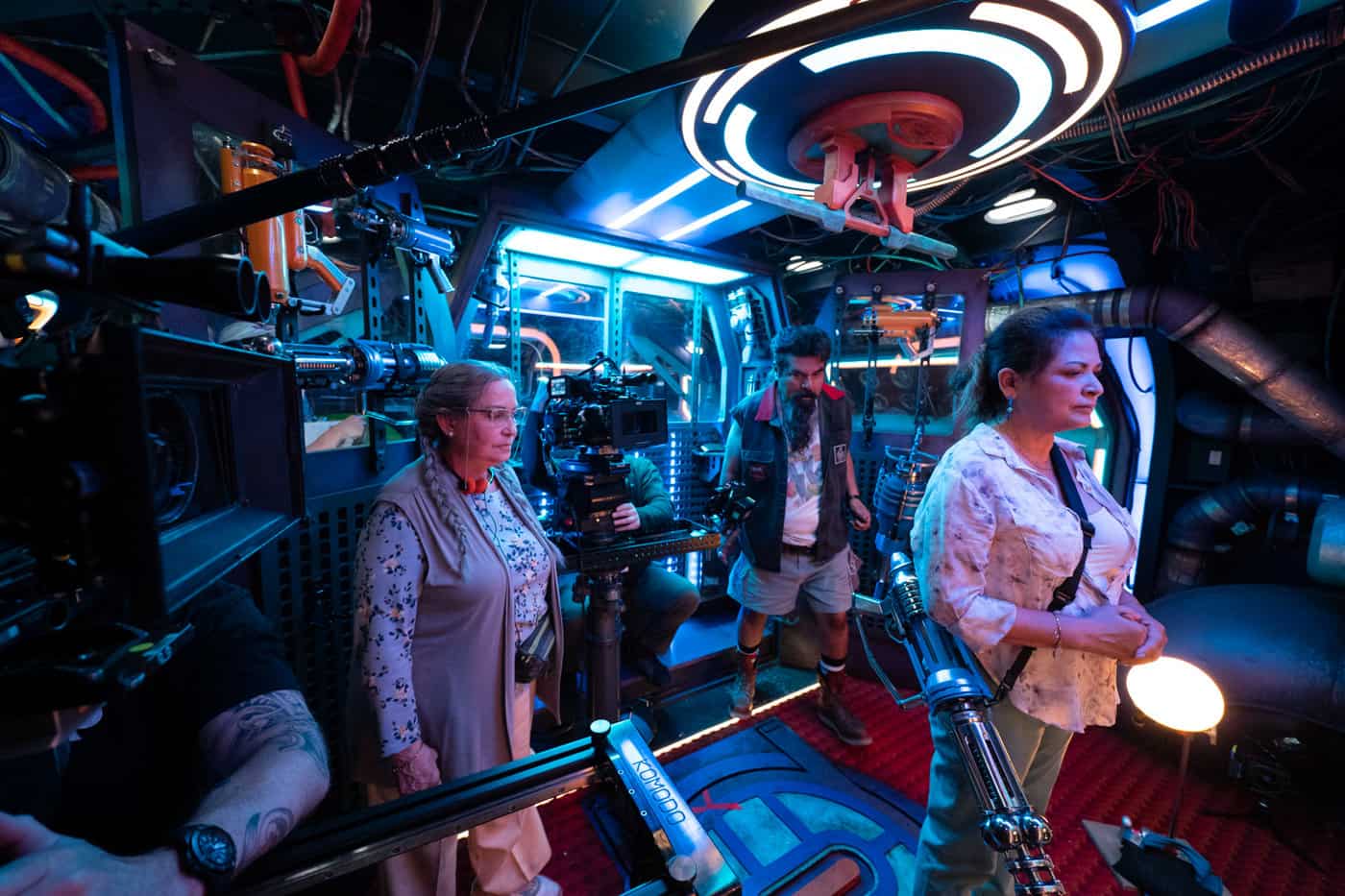
Adriana Barraza, George Lopez and Elpidia Carrillo in BLUE BEETLE
CO: And it is a great cast. Like you said, that family dynamic is really the heart and soul of the film, and the thing that distinguishes it from other movies in the genre. I bet working with that cast was just a blast.
McGuire: Oh, absolutely! And going back to the question of how it compared to other shows, technically we were doing this as kind of a scaled-down situation. Pawel and Ángel come from independent movies, so they had a certain style that they brought. With that, I certainly wanted to complement the indie way of shooting stuff, but also try to make sure that the experience I had attained from things like Iron Man 2, Venom, Guardians, and The Suicide Squad would contribute to the general look and aesthetic of the film. The way we shot Guardians with Henry Braham—the DP on that as well as Suicide Squad—we do a lot with stabilized handheld so that we’re always in there with the action. And doing Venom with Matthew Libatique, who likes using handheld gimbals as well as Steadicam and cranes. So, being able to understand all of that, and then bring that to Blue Beetle meant I had a good variety of tools for specific scenes and specific applications.
We had a lot of slider use, which generally is kind of cheating in respect of marks. You’re allowing for people to not hit their marks, but in something like the bug spaceship, there just wasn’t much room, so we used sliders quite a bit in there to enable us to have a bit of movement. We stock the crane head, which was an M7 from Chapman Leonard. The crane operator, Jason Talbert, he’s an extraordinaire with the pickle and being able to get the head in where we want it and still be able to do little tracking moves. And the head tech, Jayden York, was able to get the head as low profile as we could. We used the crane and the head a lot more than I thought we would have done in there, because there wasn’t much of a window space to get in. It was just nice to bring my experience from these big movies to this movie, which I felt was trying to portray something a bit more humble.
CO: You mentioned the director, Ángel Manuel Soto, and his background in more indie stuff. One of the interesting things this movie really does is combine the standard superhero action stuff with a lot of physical comedy as Jaime is trying to figure out how to work with the Scarab and control his powers; often fighting against the suit that he’s in. Can you tell me a little bit about shooting some of those sequences for both action as well as the physical comedy?
McGuire: Yeah, when the thing connects to him in the dining room and it all goes crazy, George’s character gets flipped across the room when he tries to pull it off, all of that was handheld. It was pretty close quarters in there, but everybody was just dialed into getting there. And I think a lot of the actors tuned into George and his timing. And Adriana, her timing was impeccable. She was amazing. So was Belissa. They all just kind of played off each other and it worked really well. And Xolo was really good at physically playing with the character of the Scarab, the Blue Beetle symbiote. He really was dialed in for that. Like I said, most of that scene was handheld, so we got in there with it. We did a few little push-ins across the arm or the body to see the Scarab kind of taking over his body. Sometimes we’d flip the sliders as well, so we can hang the head underneath and get closer to the thing that we’re shooting. Another big scene was where he chops the bus in half—the shields come out and just slice down the middle of the coach, which was cool. We physically had two halves of the bus, and a lot of that was shot with a Scorpio crane and the remote head again.
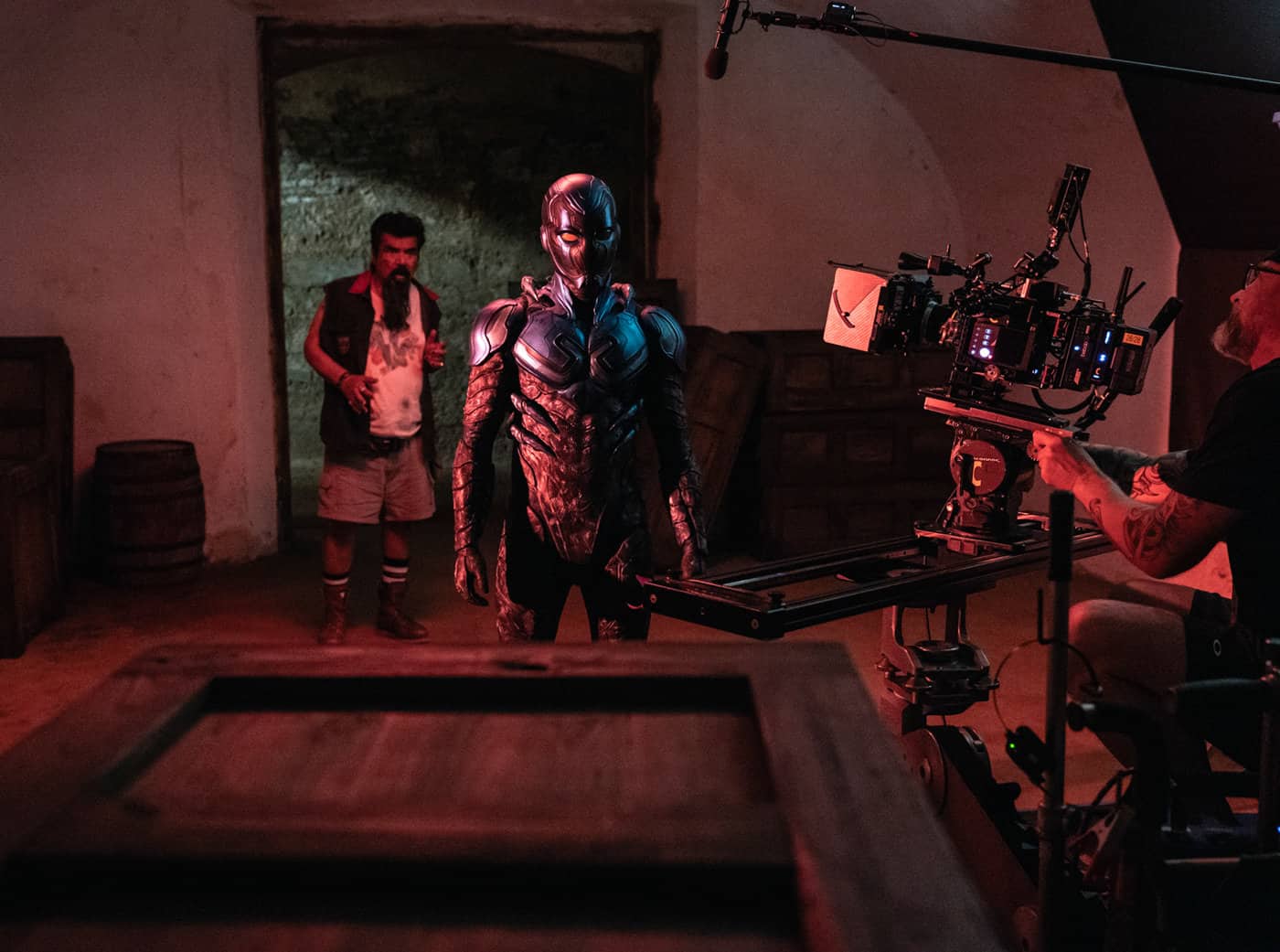
George Lopez and Xolo Maridueña with Camera Operator Christopher T.J. McGuire, SOC, ACO, GBCT, on the set of BLUE BEETLE
The other thing that we kind of kept forgetting about was the claws that come up from his back. That was something I always had to make sure that we framed for. We were shooting with two different ratios for the IMAX stuff, so I could actually judge what I needed to protect for, often as not. Generally I’ll have that conversation with the DP for when something’s going to be more specifically framed for IMAX, and a lot of the bus scene would have been shot protecting for IMAX. Anything with effects we were probably protecting for IMAX to give ourselves a bit more scope. The lenses we used were the Panavision H Series, which give you a really great clarity in respect of the size of the frame. And then they’re going right down to the swimming pool scene where the baddie, Raoul, turns up. That was a Steadicam oner. There are two oners in this. I did the one with the pool, and then Geoff Haley did the handheld oner in the house where there’s quite a bit of exposition going on, going from one character to the next. Mine was the one on the swimming pool, where you pull Raoul in and we go through, see these generals walking away from Susan Sarandon, and then we spin around, come back to him, and then we land on Susan who’s delivering her dialogue. We did that quite a few times just because of the background timing, but every time Susan was totally bang-on with her delivery. When you’re doing it, you’re just getting goose bumps because you know how many times we’ve done this, but she’s just on it every single time. It’s really amazing.
CO: You touched on this a little bit, but I wanted to dig in a little bit further into framing for both the standard 2.39:1 aspect ratio as well as the slightly taller IMAX aspect ratio. I know this is something you had done previously on movies like Guardians of the Galaxy Vol. 3, but how much do you have to keep that in your head as you’re shooting these sequences? How tricky is it to frame for both ratios simultaneously?
McGuire: Well, it depends. If you’re in a sequence where there’s going to be a lot of information, you can use it to your advantage having that extra height. Then when they are cropping it down, they can move the frame up and down within the larger image. Honestly, it’s not something that I really worry about anymore. It’s funny, I was talking to somebody recently about trying to shoot 4×3. I find that more complicated than shooting anamorphic now. It’s weird. With anamorphic you can fill that frame beautifully with whatever you shoot and you can frame it in a way where you put this just off the center punch and really play with what else is in the frame, whereas 4×3 forces you to make a decision. What is it that’s important? And you have to make sure you compose for that.

Xolo Maridueña as Jaime Reyes in BLUE BEETLE
CO: Looking at the movie as a whole, what were some of the most challenging parts of shooting the film? Were there any specific moments that stand out as particularly memorable or particularly rewarding?
McGuire: We had scene that on the surface didn’t seem complicated, but turned out to be quite complicated in shooting. It was the scene where Jaime, his uncle, and Jenny are on the roof of the old Kord house, and Jaime wants to chase after the helicopter that’s heading off to the barrios where his parents are. He runs back, then he runs forward and jumps towards the camera and takes off, transitioning into Blue Beetle as he’s flying past the lens. We had him on a line so he could be pulled towards us, but Ángel also wanted us to push into him as he’s coming towards the camera, then he was going to fly by us while we’re all still moving. He wanted to do it practically in respect of Xolo moving and us moving, and that always gets us all a little bit nervous. You have two entities coming towards each other; one is fine because it’s a crane, but the other one’s an actor who’s soft and can get hurt, and they’re hurtling towards this heavy piece of equipment. So, I kind of had to put my foot down a little bit to slow everybody’s roll about doing it.
We had to make sure that we dialed in the stunts aspect of him being pulled forward on a line and what trajectory he was going to be on so that he wouldn’t hit the crane. We extended the crane out as much as we could, so that’s our limit—we know we’re not going to go any further than that. We still want to hit our shot, that sweet spot as he’s flying by us while we’re still moving, but not going any further and risk hitting him. And his body’s hanging as well, so we have to take into consideration the movement of his legs and his feet as he’s being pulled up. Like I say, on the surface of it, those things never seem complicated, but when you’re trying to do it, and there’s that pressure of “What are we waiting for? Why are we wasting time?” We’re not wasting time. We’ve got to figure out the health and safety aspects of Xolo being thrust towards a camera that’s simultaneously been thrust towards him.
Ultimately, we put up stands and rope across the top so that we could mark out what his lowest point was going to be once we dialed in the actual trajectory of him leaving, and then we could figure out where we’d put the crane so we could pass by each other without colliding, and it was rewarding to see that shot in the final trailer. Ángel had a certain way of developing the idea for the actual shot, but doing it practically is such a different ballgame because you have got to understand the equipment—what it can do but also its limitations, making sure you work within the margins of human error. You’ve got three guys on one end of a rope pulling another guy who’s being pulled through the air, and you’ve got guys who are controlling a crane, swinging a crane, extending the arm out, moving at different speeds. All these things that have to be considered, and in the moment, you’ve just got to figure it out. Even if people are being angsty about the schedule, you have to take your foot off the pedal and be level-headed.
CO: To that point, I was reading about how a lot of this movie was done practically and shot on a lot of real locations in and around Atlanta, and then at Castillo San Felipe del Morro in San Juan. Tell me a little bit about doing those location shoots and working with practical stunts.
McGuire: The castle was amazing, but it was a nightmare for everybody getting the gear down there. There was only one way in and one way out, and it was down a rough slope of steps, so they built a little train to traverse up and down with a pulley system. Then there was a shot deep in the castle where George Lopez and Belissa are searching for Xolo, and we put a jimmy jib down there because there was no other way of putting a crane in to do this shot. Ángel wanted to start really high looking down, then drop the camera down as they run in. Obviously that was a kerfuffle getting all that gear down in there, but it was great because the shot worked a treat, and it was a great-looking shot there in the bowels of the castle. That’s the thing, I really hope everybody that are involved in those situations, when they get to see the shot, they say it was worth it. And that was a cool shot; I’d say it’s probably one of the coolest shots of the movie. Pawel had some great ideas in terms of the practicality of moves, and the second unit team led by J.J. Perry and Bruce McCleery, they did some really amazing stuff in the castle as well. Especially with the spaceship coming into land. That was pretty amazing stuff.
Then the finale with the big burns was all on the grounds further down from the castle, so most of that was VFX backgrounds. There is a funny little story about that scene where something falls—I think it’s the control that Susan’s character has—it falls to the ground and we wanted to get as low as we could to shoot across the item to Susan. We didn’t have a prism lens or anything like that, so we’re trying to get the camera as low as we could, and I said, “Well you know, let’s just dig a chunk out of the grass there so I can get the camera lower.” So, we did that and we got the shot, and it was all fine. The next day something else came up about maybe digging some turf up, and they said, “Nope, can’t do that.” Turns out the production had been fined for digging a divot out of the national heritage site. I forgot exactly how much they were fined—something like 10 grand—so that we could do the shot, which always tickles me after the fact. You kind of go, “Well, this is how we do it,” and it only takes one person to say we can’t do that and maybe we try and do something different, but we always go to the simplest way of fixing a problem first. “Let’s just dig a hole and get us lower.”
CO: In that case it was a $10,000 hole.
McGuire: Thinking of other locations, there’s a shot of Jaime that made it into the very first trailer where it makes out that he’s a millionaire, with cameras pushing into him as he turns outside of the house. That’s a beautiful house in Puerto Rico. Again, that was a nice subtle slider move. We did a lot of those little pushes that Pawel was really into. And then in the barrios, that was mostly crane work. A lot of Steadicam for when all the soldiers turned up. Just a good use of the tools across the board really for this movie. That’s the thing these days. I get the whole handheld thing, I’ve done stuff with Barry Ackroyd that’s all handheld. There’s certain things that that works for, but especially if it’s VFX orientated, you want the camera to be a little bit more compound in its moves so the VFX artists have a bit more leeway to work with. If the camera’s moving too much, they’re more limited in their options for how to integrate their modeling of the world into what we’re shooting. Yeah, you could do this handheld, but maybe we should do it on a remote head to give ourselves a little bit more room for the action that’s going to be added to the shot.
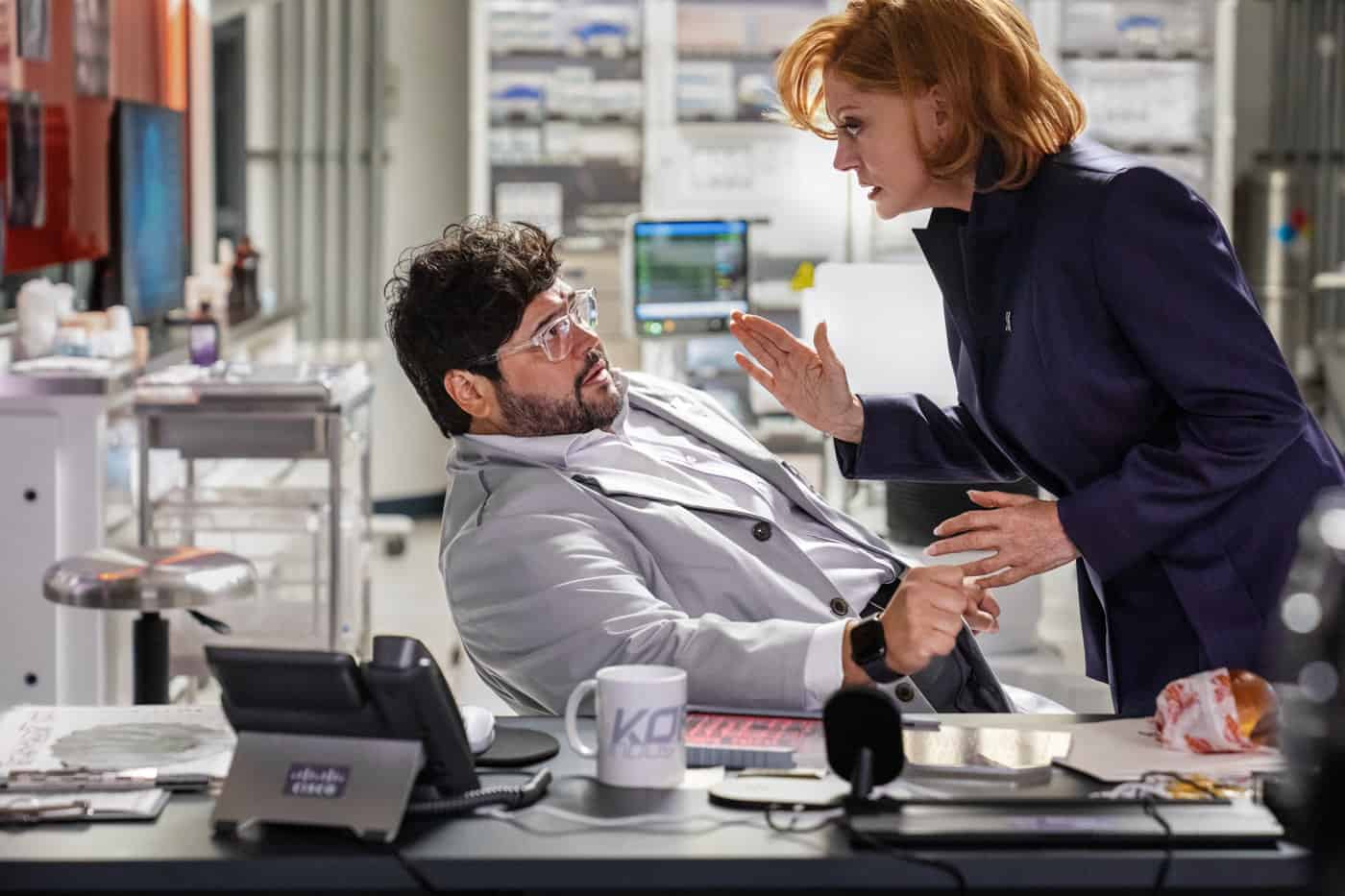
Harvey Guillén as Dr. Sanchez and Susan Sarandon as Victoria Kord in BLUE BEETLE
CO: Yeah, absolutely. Like you said, there’s a different quality to it from a lot of other superhero movies, and for the people who have seen it, I think it has resonated in an interesting way, especially in the Latino community.
McGuire: Yeah, it’s awesome. I think the casting was pretty much perfect. They were all brilliant. Couldn’t have asked for anything better in that respect. I just think it’s a shame that it came off the back of Oppenheimer and Barbie. As much as people are saying everyone’s down on superhero stuff, I just think timing is always a killer. People are still having to make decisions as to whether they’re going to risk going to the theater. There’s still a COVID aspect to everything as well.
CO: Right, there’s COVID, and there are costs. I went to the movies yesterday, forgetting that it was National Cinema Day where all the tickets were just $4, and it was crazy to see how packed every single showing was. I think we lost something important when we lost second run and discount theaters where people could take a chance on seeing something that was maybe not their most anticipated movie of the year. When a ticket for an evening show costs $20 now, it’s understandable that people would be more selective. It would be nice if there were more avenues for these movies to get a second wind like they used to be able to.
McGuire: I totally agree. Especially being a father of two kids and wanting to go and see stuff with them, I’m pretty selective now. Like you say, it’s a lot of money to drop to go and see something that you’re kind of not sure about. Coming back from England, I watched a few movies on the way home. I watched Jerry and Marge Go Large. Great! Would I have gone to the theater to see that? No. I saw the Bill Nighy movie, Living. Great movie! Would I have gone to the theater to see it? No. And there was the one that Paul Mescal was nominated for, Aftersun.
CO: Oh yeah! That one’s really good.
McGuire: Would I have gone to the theater? No. You know what I mean? They’ve changed the landscape in regards to what people are going to go and spend the money on at the theaters, and generally it’s the big glossy movies they’re going to see. Back when I was younger, you would go and take a chance on going to see something like Aftersun at the theater because that was the only place you were gonna see it.
CO: Yeah, absolutely.
McGuire: I remember the days that we would say, “So it’s gonna get released in the U.S. on this date, so that means that we’ll get it in the U.K. on this date, and so when will it release on VHS? That’s going to be at least six months, maybe up to a year.” All of that added to the hype of being excited to see the movie again. Now something will be out on video on demand next week.
CO: And even just 15 years ago it’d play in theaters, then move into second run theaters, and after that it go to home video, then premium cable, then basic cable. There were all these opportunities for people to discover it, and now unless it’s something like Barbie or Avatar or Top Gun, it’ll play in theaters for maybe a month at the most and then get buried on streaming. There’s just not as much opportunity for people to come across something and say, “Oh, wow, this is really good.”
McGuire: Oh, totally. It’s an obvious reason for things changing so much, and especially with situation we’re in right now. It’s a shame because I think that Blue Beetle could have excelled in that respect if maybe the timing was a little bit more in its favor. But even as it turned out, it’s so good to be involved with these projects, especially new ones that are trying to go off in a different direction, trying to do something different. And, it was cool to work with Ángel and Pawel. Pawel did Midsommar with Ari Aster. He has a certain way of thinking about narrative so this was really out of his wheelhouse, but it was good, and he really did listen to things that I suggested. It’s nice to have that collaboration. When you do something with James Gunn, the vision is so specific. You’re just there to service the vision. But it’s nice to get these jobs where you are able to collaborate more with the DP and the director. Blue Beetle was definitely one of those for me.
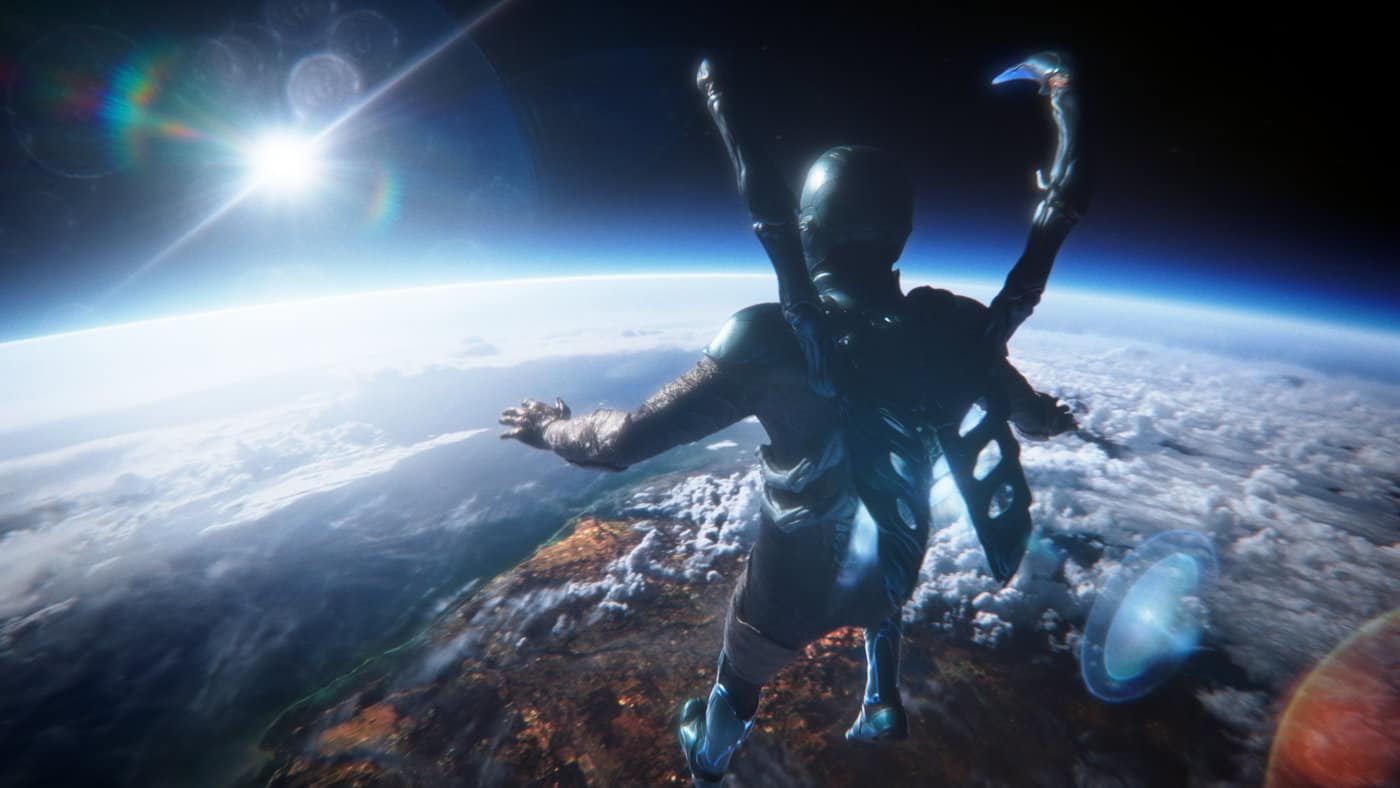
Xolo Maridueña as Jaime Reyes in BLUE BEETLE
Camera Operator Fall 2023
Above Photo: Xolo Maridueña as Jaime Reyes in BLUE BEETLE. Photo by Hopper Stone, SMPSP
Photos courtesy of Warner Bros. Pictures
TECH ON SET
Panavision H Series Lenses
Primo 10-1 Zoom
2 x ALEXA Mini LF
1 x RED Raptor
Mitchell Filters
Chapman Leonard M-7 Remote Head
45-foot Scorpio Crane
RELATED CONTENT
Watch the Trailer for Blue Beetle
Christopher T.J. McGuire, SOC, ACO, GBCT
Learn more about Christopher’s career and projects at IMDB.com
Camera Operator
“Dear Evan Hansen: Wisdom from the Set,” Fall 2021
BEHIND THE SCENES
Select Photo for Slideshow
Christopher T.J. McGuire, SOC, ACO, GBCT
Chris McGuire began his career in the UK on various TV shows including World in Action, This Morning, Dispatches, and Planet Pop, then moved into feature films. He contributed to the early-stage development of what is now called the Omega from MK-V, and used it on many productions including Iron Man 2 and Harry Potter and the Order of the Phoenix. As owner and operator of this equipment, he was able to open up new possibilities for use in both the commercial and motion picture worlds, as well as continuing to photograph narrative using all the different platforms available.
McGuire’s eclectic resume as A Camera / Steadicam operator includes True Detective Season 1; The Suicide Squad; Terminator: Dark Fate; Detroit; American Made; Bad Boys for Life; and Pitch Perfect 1, 2, and 3. Chris endeavors to be true to his passion for movie making, commits himself to the craft, and encourages all of his colleagues the best he can. With the release of his Steadicam Warriors—with designs featuring caricatures of animals operating Steadicams—he hopes to bring together all of his Steadicam / camera colleagues as a collection of hard-working caricature personalities.

David Daut
A writer and critic for more than a decade, David Daut specializes in analysis of genre cinema and immersive media. In addition to his work for Camera Operator and other publications, David is also the co-creator of Hollow Medium, a “recovered audio” ghost story podcast. David studied at the USC School of Cinematic Arts and works as a freelance writer based out of Long Beach, California.
